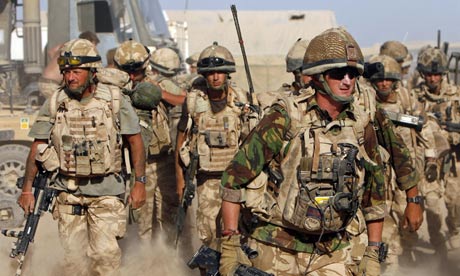British troops holding crucial area of Helmand
• Commander describes 'incredibly hard fight'

British soldiers from B Company, 2 Mercian, set off on an operation in Malgir, Helmand province. Photograph: Omar Sobhani /Reuters
Hundreds of British troops are holding a crucial, heavily-populated area of Helmand province that had been controlled by the Taliban since the start of the war in Afghanistan, military commanders said today.
The capture of the strategically important zone came after a five-week battle involving fierce fighting and signalled the end of Operation Panther's Claw, a campaign that commanders hope will be a decisive turning point in the eight-year conflict. The operation took nearly 3,000 British troops, many engaged in gun battles, to capture an area the size of the Isle of Wight.
Giving details of the operation, its commander Brigadier Tim Radford declined to put a figure on the number of Taliban who had been killed, though he said they had suffered "significant losses". There had been up to 500 Taliban fighters in the area at the start of Panther's Claw, he said. Some of the "less committed" would have fled. Others would have "melted back into the local population", he predicted.
British troops had encountered 153 improvised explosive devices (IEDs) – the main cause of British deaths and injuries. Though more soldiers were killed in the buildup to the surge – 22 have been killed in Helmand province so far this month – 10 have been killed during it. The British soldier killed while fighting there on Saturday was named today as Bombardier Craig Hopson, 24, of the Royal Artillery.
Radford described the operation as having had "a major impact on Taliban capability and morale in the main population centres of central Helmand" – that is, between Gereshk, Helmand's economic and commercial centre, and the capital Lashkar Gah.
Radford today gave the fullest description so far of the operation, which began on 19 June when 350 Black Watch soldiers conducted a risky air attack on what the brigadier called a "Taliban drugs bazaar" and a key canal crossing.
The Welsh Guards, who had earlier lost a number of officers, including their commander, then secured 14 canal crossings in the river valley. They were supported by a Danish battlegroup with armoured vehicles, which seized further crossing points along the Nahr e Bughra canal, enabling the Light Dragoons to move deep into Spin Masjed, a Taliban stronghold.
"The Light Dragoons were engaged in an extremely hard fight for five days ... an incredibly hard fight," Radford said. In the course of it they came across 153 IEDs and more than 50 small arms.
In the next stage of the operation, British troops, including the 2nd Battalion the Mercian Regiment and more Afghan forces, gained control of more and more territory along the valley.
More soldiers of the Black Watch, flown in by Chinook helicopters, were dropped into an area near Babiji and linked up with the Light Dragoons who were making their way down from Spin Masjed.
By 20 July, the last phase of the operation, British forces, including soldiers from the Royal Welsh Regiment, met little resistance along the main road running north-south along the valley. Radford praised his troops, saying they had shown the "most incredible courage and fortitude".
British commanders suggested they would not have planned such an operation without the US. Some 10,000 US troops are now in Helmand beefing up the military presence provided by 9,000 British troops there. While the British were engaged in Panther's Claw, US marines were fighting the Taliban further south in the district of Garmsir. The point commanders made is that British troops might have been able to mount such an operation as Panther's Claw, but without US support would not have had enough resources to stay there.
The significance of the operation, they said, is that they could with conviction tell the local population that British troops would remain and not soon leave, allowing the Taliban to return. Hugh Powell, the senior Foreign Office diplomat in Laskar Gah, said British reconstruction teams, building schools and providing water, would stay. They would have a "permanent footprint" in the area, he said.
Up to 80,000 Afghans lived in the area, and British officials are anxious that the local population will be able to participate in next month's presidential elections.
Driving home the point that Britain will stay for some time, Powell said: "We are staying beyond the elections." The task now, he added, was to build up the trust of the Afghans and get them to use a special hotline to report Taliban movements and where the IEDs were buried.
British officials, military and civilian, made comparisons with Northern Ireland, making it clear they hoped that Panther's Claw, more than three years after British troops were deployed to Helmand, would mark the start of a credible counter insurgency operation that would attract the hearts and minds of local people.
They also made plain the next few months will be crucial, for decisive military action against the Taliban and other insurgents, and to convince public opinion in Britain that Afghan forces will increasingly take responsibility for their country's security. The task for British and other foreign troops would then be to train Afghan forces and set up a lasting civil infrastructure.
The counter-insurgency strategy was "not against the Taliban, but for the Afghan people", Lieutenant-General Simon Mayall, deputy chief of defence staff, said yesterday. Gordon Brown said: "I'm very proud of what our forces have achieved over the last few weeks – indeed for all the time they've been in Afghanistan."
